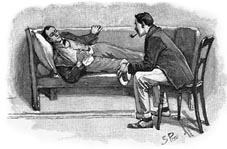
Sherlock Holmes and Japan
Tsukasa Kobayashi
In the Canon, we can find 6 items which related to Japan. These are "Japanese cabinet"(The Gloria Scott),"Japanese armour"(The Greek Interpreter),"baritsu"(The Empty House),"the Emperor Shomu" and its association "with the Shoso-in near Nara"(The Illustrious Client), and "Japanese vase"(The Three Gables).
Two of these require explanation. First, what is the "baritsu" ? According to H.R.F.Keeting, it might be a kind of wreath ring, mixture of Judo and Karate. At the time, in the late Victorian London, E.W. Barton-Wright had opened school to teach his own technique of self-defense which he called "Bartitsu" after his own name "Barton". It is likely that Sir Arthur Conan Doyle was intending to use this name and that he copied it incorrectly.
Secondly, who is the "Emperor Shomu" and what is a "Shoso-in"? He was the 45th Emperor(701-756) in Japan. He was a devout Buddhist who constructed many Buddhist temples all over Japan, including the famous Todaiji Temple in Nara City. This is the biggest wooden construction in the world heritage
site by UNESCO. In 752, the Emperor placed within it the largest statue of
Buddha, that had yet been made. It was over 1485 cm high, and weighted two
hundred and fifty tons. The Shoso-in is the word used to describe a group
of storehouses which contain the temple treasure, and at Todaiji it is
found in the north-west corner of the temple precinct.
When the Emperor passed away in 756, his wife, Komyo gave the temple six
hundred and thirty-seven valuable artifacts and sixty medicines which had
belonged to him, and these were stored in the Shoso-in. Later, in 950, the
Temple contributed further treasures to the Shoso-in. The nine thousand artifacts from these two sources were conserved in Shoso-in for 1244 years . They include stationary, tools, musical instruments, pottery, and document etc. Some came from Rome, Greece, Egypt, India and Iran via the Silk-road
and together they represent much of the best of world culture in the 8th
century.
Sherlock Holmes reached Japan for the first time in 1894 when an abridged Japanese version of "The Man with the Twisted Lip" was published in the
January issue of a magazine "Nippon-jin". In April 1899, the newspaper "Mainichi Shinbun" began a three-month series featuring an adaptation
(by unknown translator) of"A Study in Scarlet", and between 12 July and 4 November of the same year, the "Chuo Shinbun" newspaper published the first complete Japanese translation of a Holmes story, "The Adventures of Sherlock Holmes", in a translation by Gaishi Nan-yo. The first book-length translation appeared in 1907. After that, Sherlock Holmes was always popular in Japan, but it was not until 1955, twenty-nine years after Conan Doyle finished his last Holmes stories, that the translation of all 60 stories by Ken Nobuhara appeared in Japan.
The Japan Sherlock Holmes Club was founded in 1977 by our proposal. (
my wife and I were those first proposed it ). In 1988, it erected the statue of Sherlock Holmes in Karuizawa Town, and today it has nine hundred members.
Between 1907 and September 1997, there were ninety-five separate translations Sherlock Holmes stories in Japanese, thirty four adaptations for children, two hundred and forty-nine parodies and pastiches, and nearly four hundred other pieces of Sherlockiana.
According to the survey of libraries in Junior High Schools in Japan,
translated Sherlock Holmes stories have for many years been among
the top five titles which are most often read or requested. In 1999 the
Sherlock Holmes stories were voted the best mystery in the world by EQ (=Japanese Ellery Queen's Mystery Magazine" ) .
Sherlock Holmes is the most famous English person in Japan, and better known than either the Beatles or the late Princess Diana(who follows in the second and the third place).
--- Editor's note
Pictures of Shoso-in and others will be appearing shortly.

